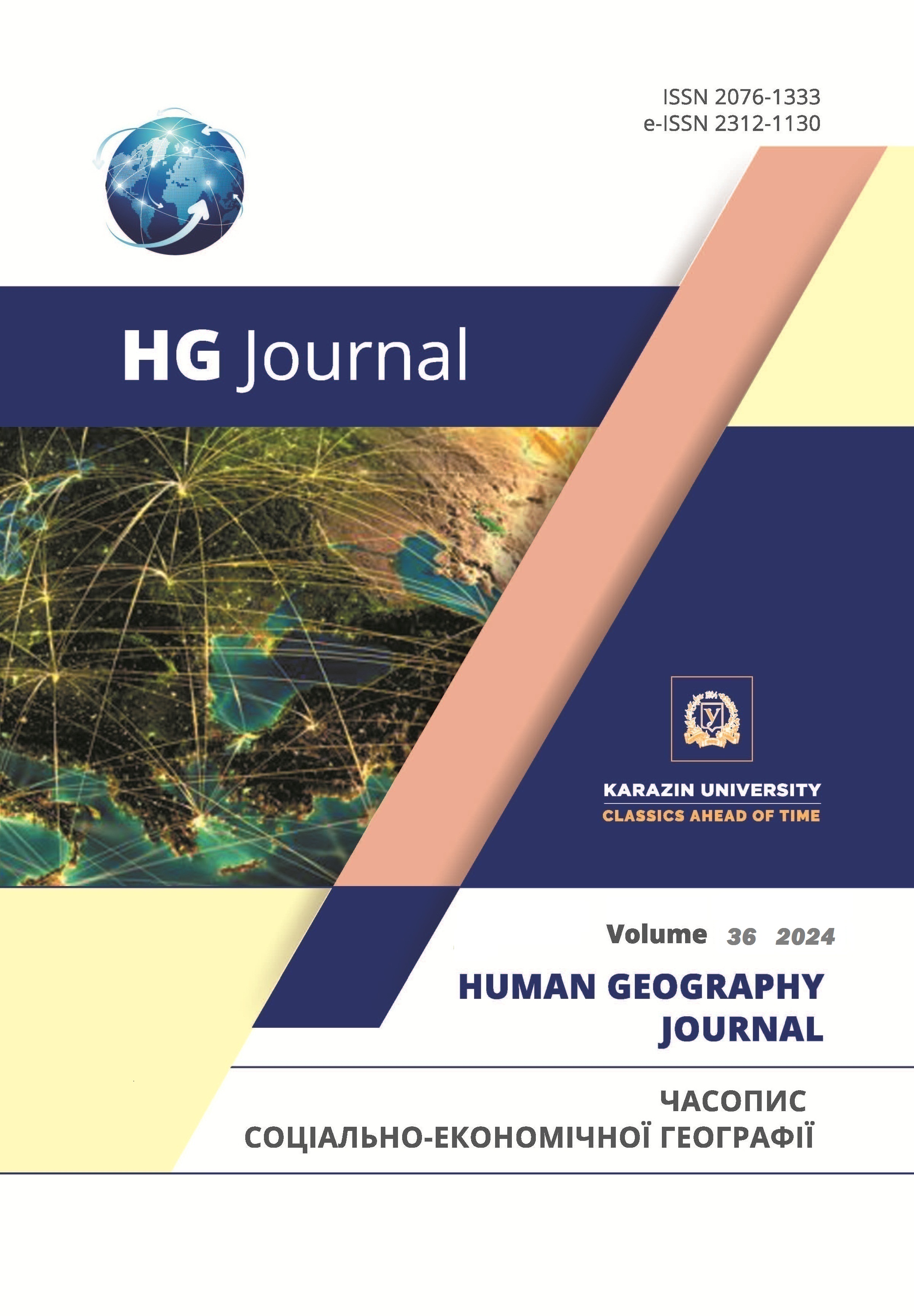Military urbicide against Ukraine
Abstract
The article examines the phenomenon of "urbicide" or the targeted destruction of cities as an actual problem in modern conflict zones, focusing on its appearance in contemporary conflicts, in particular in Kharkiv, Ukraine, due to Russia's military aggression. The study emphasizes the devastating impact of urbicide on the civilian population, the urban landscape, the city's social, transport and critical infrastructure, and its cultural heritage. The study highlights the need for a multidisciplinary approach, especially through the lens of human geography, to understand the causes and consequences of urbicide and to identify ways to restore affected cities.
The authors emphasize that, regardless of the territorial localization of this phenomenon, its consequences have a long-term perspective and impact on the entire world community. It requires international intervention and support, humanitarian aid and strategies to restore affected cities and prevent future crises, emphasizing global security and economic consequences of urbicide.
The article studies and analyzes the spatial aspects and consequences of urbicide, presents a comprehensive analysis of its stages and forms, investigates geographical features and determines the socio-economic consequences in the territory of the city of Kharkiv. The authors note that urbicide was used by the Russian military as a strategic and manipulative tool. The study examines three main scenarios of urbicide observed in Ukraine, including Donetsk, Mariupol and Kharkiv, where Russian tactics ranged from selective terror to large-scale extermination. The study identifies how urbicide goes beyond physical destruction to affect the mental well-being of the population, and demonstrates how regional factors, such as proximity to an active frontline, increase vulnerability to urbicide.
The authors emphasize that urbicide remains a tool of warfare with far-reaching socio-economic consequences, which requires the response of the world community to support the post-war reconstruction of cities and prevent further international instability.
Downloads
References
Larin, Yu. (2023). Shkola v metro: Yak navchatymutsia dity pid zemleiu v Kharkovi [School in the subway: How children will study underground in Kharkiv]. Dumka. Retrieved from https://dumka.media/ukr/suspilstvo/1693573223-shkola-v-metro-yak-navchatimutsya-diti-pid-zemleyu-v-harkovi [in Ukrainian].
Mariupolskyi dramteatr: rik potomu. Realnyi zlochyn ta strashni feiky rashyzmu [Mariupol Drama Theater: a year later. Real crime and terrible fakes of rashism]. Tsentr stratehichnykh komunikatsii ta informatsiinoi bezpeky (2023, March 15). Hlavkom. Retrieved from https://glavcom.ua/publications/mariupolskij-dramteatr-rik-potomu-realnij-zlochin-ta-strashni-fejki-rashizmu-914675.html [in Ukrainian].
Mykhailova, O. (2022). Urbitsyd – stratehiia rosiiskykh okupantiv v rosiisko-ukrainskii viini [Urbicide is the strategy of the Russian occupiers in the Russian-Ukrainian war]. Natsionalnyi instytut stratehichnykh doslidzhen. Retrieved from https://niss.gov.ua/news/komentari-ekspertiv/urbitsyd-stratehiya-rosiyskykh-okupantiv-v-rosiysko-ukrayinskiy-viyni
[in Ukrainian].
Nedilko, K. (2023). U Kharkovi ta oblasti nazvaly raiony, yaki naibilshe postrazhdaly vid viiny [In Kharkiv and the region, the districts most affected by the war were named]. Comments.ua. Retrieved from https://kharkov.comments.ua/ua/news/war/2023/23083-u-harkovi-ta-oblasti-nazvali-rayoni-yaki-naybilshe-postrazhdali-vid-viyni.html [in Ukrainian].
Pisliavoienne vidnovlennia Ukrainy: yaki krainy vzialy shefstvo nad mistamy ta oblastiamy [Post-war reconstruction of Ukraine: which countries took over cities and regions]. (2023). Slovo i Dilo. Retrieved from https://www.slovoidilo.ua/2023/03/01/infografika/suspilstvo/pislyavoyenne-vidnovlennya-ukrayiny-yaki-krayiny-vzyaly-shefstvo-nad-mistamy-ta-oblastyamy [in Ukrainian].
Tudy pryishov «ruskyi myr»: yaki mista Ukrainy buly povnistiu abo chastkovo zruinovani pid chas viiny [The "Russian peace" came there: which cities of Ukraine were completely or partially destroyed during the war] (2023). Slovo i dilo. Retrieved from https://www.slovoidilo.ua/2023/02/03/infografika/suspilstvo/tudy-pryjshov-ruskyj-myr-yaki-mista-ukrayiny-buly-povnistyu-abo-chastkovo-zrujnovani-vijny [in Ukrainian].
KharkivToday (2022). Kharkivski pereselentsi. Skilky yikh rozkydano po Ukraini [Kharkiv settlers. How many of them are scattered across Ukraine]. Retrieved from https://2day.kh.ua/ua/kharkow/kharkivski-pereselentsi-skilky-yikh-rozkydano-po-ukrayini [in Ukrainian].
Apostvof (2024). Yak zaraz vyhliadaie zruinovana TETs u Kharkovi: foto [What the destroyed CHP in Kharkiv looks like now: photo]. Retrieved from https://apostrophe.ua/ua/news/society/2024-03-26/kak-seychas-vyiglyadit-razrushennaya-tets-v-harkove-foto/317304 [in Ukrainian].
Appadurai, A. (1996). Modernity at large: Cultural dimensions of globalization (Vol. 1). London: University of Minnesota Press [in Ukrainian].
Clements-Hunt, А. (2022, June 07). Russia’s Campaign of Urbicide in Ukraine. New Lines Institute. Retrieved from https://newlinesinstitute.org/rules-based-international-order/russias-campaign-of-urbicide-in-ukraine/
Convention on the Prevention and Punishment of the Crime of Genocide. United Nations. United Nations Human Rights Office Of The High Commissioner. Retrieved from https://www.ohchr.org/en/instruments-mechanisms/instruments/convention-prevention-and-punishment-crime-genocide
Coward, M. (2010). Urbicide: The Politics of Urban Destruction By Martin Coward. Global Discourse, 1(2), 186-189. https://doi.org/10.1080/23269995.2010.10707864
Exploring the future of the “Century of the city” (2012). United Nations Economic Commission for Europe. Retrieved from https://unece.org/press/exploring-future-century-city
Gutiérrez-Sanín, F., & Wood, E.J. (2017). What Should We Mean by "Pattern of Political Violence"? Repertoire, Targeting, Frequency, and Technique. Perspectives on Politics, 15(1), 20-41. https://doi.org/10.1017/S1537592716004114
Graham, S. (2004). Introduction: Cities, warfare, and states of emergency. In: S. Graham (ed.), Cities, war, and terrorism: Towards an urban geopolitics. Oxford: Blackwell Publishing, p. 1-25.
Hoy, D. (2012). Urbicidio: la violencia urbana. Retrieved from https://works.bepress.com/fernando_carrion/522/
Lawrence, J.Ch. (2018). Urbicide: the killing of a city is an attack on the human condition. City Monitor. Retrieved from https://citymonitor.ai/environment/urbicide-killing-city-attack-human-condition-3617
Malchykova, D., & Pylypenko, I. (2022). Occupation urbicide: urban experience and everyday practices of the population (a case of Kherson, Ukraine). Ekonomichna ta Sotsialna Geografiya, 88, 6-15. Retrieved from https://doi.org/10.17721/2413-7154/2022.88.6-15
Mezentsev, K. & Mezentsev, O. (2022). War and the city: Lessons from urbicide in Ukraine. Czasopismo Geograficzne, 93(3), 495-521. Retrieved from https://doi.org/10.12657/czageo-93-20
Safier, M. (2001). Confronting “Urbicide”: Crimes Against Humanity, Civility and Diversity and the Case for a Civic Cosmopolitan Response to the Attack on New York’. City. 5:3, 416-429.
Sharp, D. (2016). Urbicide and the Arrangement of Violence in Syria. Beyond the Square: Urbanism and the Arab Uprisings. Pub-lisher: Urban Research, 118-140.
Shaw, M. (2008). New Wars of the City: Relationships of “Urbicide” and “Genocide”. Cities, War, and Terrorism: Towards an Urban Geopolitics, 141-153.
State of the World’s Cities 2008/2009. Harmonious Cities. London: Sterling, VA. Retrieved from https://sustainabledevelopment.un.org/content/documents/11192562_alt-1.pdf
Stathis Kalyvas (2006). The Logic of Violence in Civil War. Cambridge: Cambridge University Press.
Straus, S. (2012). “Destroy Them to Save Us”: Theories of Genocide and the Logics of Political Violence. Terrorism and Political Violence, 24(4), 544-560. https://doi.org/10.1080/09546553.2012.700611
Woodward, R. (2005). From Military Geography to militarism’s geographies: disciplinary engagements with the geographies of militarism and military activities. Progress in Human Geography, 29(6), 718-740. Retrieved from https://doi.org/10.1191/0309132505ph579oa
Wright, J.L. (2016). Urbicide: The Ritualized Killing of Cities in the Ancient Near East, in Saul M. Olyan (ed.), Ritual Violence in the Hebrew Bible: New Perspectives. New York, online edn, Oxford Academic.
Copyright (c) 2024 Kliuchko L., Bedrii Ye., Khabusev Ye.

This work is licensed under a Creative Commons Attribution 4.0 International License.




